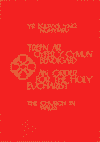Y Cymun Bendigaid
 A package containing a new book landed through my letter box a couple of days ago. It was a copy of the newly-authorized version of the Eucharist of the Church in Wales, published just in time for a meeting of the Church’s Governing Body in September.
A package containing a new book landed through my letter box a couple of days ago. It was a copy of the newly-authorized version of the Eucharist of the Church in Wales, published just in time for a meeting of the Church’s Governing Body in September.
 (The Archbishop of Wales, the Most Revd Barry Morgan, can be seen at the meeting using what looks like a copy of the altar edition of the book in this picture.)
(The Archbishop of Wales, the Most Revd Barry Morgan, can be seen at the meeting using what looks like a copy of the altar edition of the book in this picture.)
The arrival of this book was a significant moment for me — because I had designed and typeset it. Having laboured long and hard over the text and layout, over page breaks and line breaks, vertical and horizontal spacing, typeface, kerns and ligatures, page numbers and goodness knows what else, here at last was the finished product.
This is always an exciting event: to hold in your hands the result of your own craftsmanship, your own hard work, and to be able to see for the first time whether it has actually worked, whether you have achieved the effect that you wanted — in this case clarity and beauty combining tradition and modernity.
Of course, many people had contributed to this volume, in ways significantly more important than I had. Liturgists had worked on drafts, revision committees and the Governing Body had considered it, and altered it to produce the final authorized text; others had created the cover (by Leigh Hurlock) and the calligraphy (by Shirley Norman); and the printer (Biddles) had produced the printed and bound books. But I shall remember the time spent designing a layout that works, selecting typefaces, playing with type size, and different combinations of bold and italic and roman, caps and small caps, creating custom ligatures (Welsh requires an ‘fh’ ligature which did not exist in the selected face, so I had to design one myself in roman, italic, bold and bold italic), and of course proofreading the text over and over again. Proofreading, especially of the parallel Welsh text, was also done by people at the provincial office of the Church in Wales. All in all, the result is a book to be very pleased with, I think.
And then after all that, despite all the care that has gone into its production, you begin to notice the mistakes. Here and there, dotted around, are little glitches that have escaped the proofreading. It’s amazing that you can proofread a text so many times, both on screen and on paper proofs, and yet the minute you pick up the finished product you find a few more mistakes.
I suppose life is like that — you cannot produce the perfect work, there are always a few little things wrong. At least with a book there is a chance to correct any errors at the next printing! Mistakes in life, on the other hand, very often have to be lived with.
3 CommentsLife's Solution
Life’s Solution is the title of a new book by Simon Conway Morris, Professor of Evolutionary Palaeobiology at Cambridge University. The subtitle Inevitable Humans in a Lonely Universe encapsulates what seems to be the book’s central thesis: that on an earthlike planet, the patterns of evolution are such that they will eventually bring intelligent life into being, but that there are precious few earthlike planets in the universe.
I plan to make further comments as I read the book; meanwhile you can buy it here — it looks well worth a read, though it’s a fairly demanding work.
0 Comments